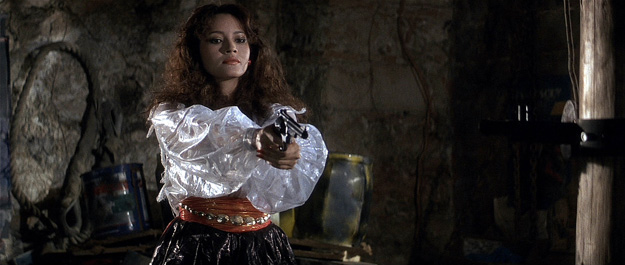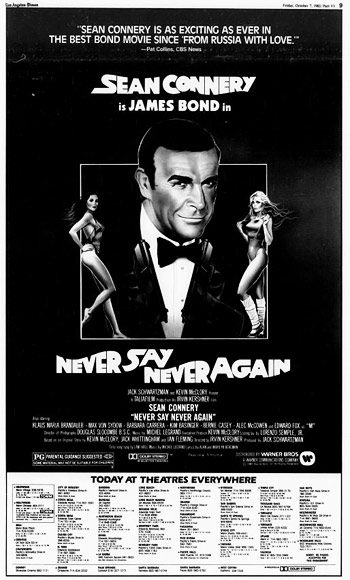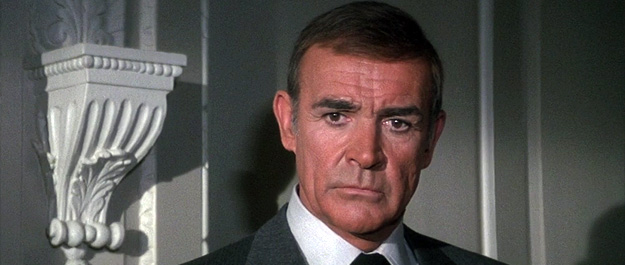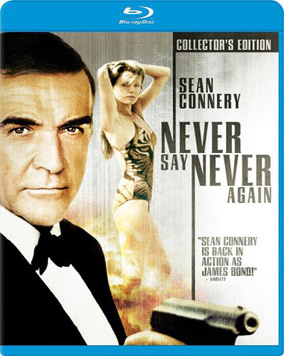
Coate: In what way was Klaus Maria Brandauer’s Largo (or Max von Sydow’s Blofeld) a memorable villain?
Christie: Whereas Adolfo Celi’s sixties take on Largo had been dominated by the character’s glowering disposition and barely-contained temper, Brandauer’s contemporary approach to this villain was quite different – coldly charming, distant and sadistic, when his fury does boil over it seems all the more effective because of the way it clashes with his otherwise cool external demeanor. This variation on Largo is just as brutal and dangerous as his 1965 equivalent but also more darkly calculating in his malign intentions, lending him greater depth and making him a more complex villain as a result. By comparison, von Sydow’s Blofeld seems curiously genial and paternalistic for a criminal mastermind. Though as erudite and sophisticated as ever, this Blofeld’s sense of threat is blunted by the character’s apparent amiability and almost grandfatherly quality, meaning that he appears almost as anomalous a figure as Charles Gray’s archly witty but strangely toothless version of the SPECTRE chief in 1971’s Diamonds Are Forever. Given that much of von Sydow’s screen time is reputed to have been left on the cutting room floor after the film was edited, however, we may never know if this incarnation of Blofeld may have had more in common with his cinematic forebears had the entirety of his appearance survived into the eventual theatrical cut.
Cork: “Sweet, like money!” Brandauer’s Largo is introduced inauspiciously via a distant video screen blathering exposition. His first scene where he’s not on a video monitor comes over 35 minutes in when he lands on his yacht and goes out of his way to politely tell his staff, “Good morning.” He plays Largo as if he were a frustrated romantic poet. He is far more obsessed with Domino than with his mission to extort the Western powers. When she asks Largo what would happen if she ever left him, he gets an expression on his face of someone experiencing sudden explosive diarrhea. This is not a man with the focus and control to plot global extortion. There is never any menace in his performance, his glance often wandering around like a kitten fascinated by a flashlight beam. Much of his mannerisms lead one to assume his inspiration was Jerry Lewis in The Nutty Professor. That said, one can see the villain he could have been with the comparatively brilliant performance he gives during the Domination game scene.
Things are not helped by the usually amazing Max von Sydow as Blofeld. In some of the original material that became the basis for Thunderball, it was suggested that Burl Ives (the affable snowman in the old Rankin-Bass Rudolf the Red-Nosed Reindeer Christmas special) could play Blofeld, and Max von Sydow seems to have been informed of this and does his best Burl Ives impersonation.
Pfeiffer: Film critics Roger Ebert and Gene Siskel were quite influential in 1983 and they both thought Never was terrific. I think they cited Brandauer as the best Bond villain ever. I wouldn’t go that far but his performance is certainly very inspired. He has all the ingredients of the classic Bond villain: he’s sophisticated, witty, and charismatic. He wisely chose not to emulate Adolfo Celi who played Largo in Thunderball and whose performance is much-beloved by fans. Instead, he made the role his own and did an excellent job of it.
Coate: In what way was Kim Basinger’s Domino (or Barbara Carrera’s Fatima Blush) a memorable Bond Girl?
Christie: Kim Basinger brings a welcome sense of credulity to Domino; the character becomes more sympathetic and relatable as a result of her grief and sense of betrayal at the hands of Largo and his murderous machinations. She is capable and resourceful, yet also frequently out of her depth as a result of Largo’s constant scheming; Bond’s genuine concern for her, especially when rescuing her after Largo sells his unsuspecting lover into captivity, makes this one of the more emotionally impactful romances for 007. On the other end of the spectrum, Barbara Carrera seems to be having a lot of fun as the ruthless Fatima Blush. The character, who is an updating of Luciana Paluzzi’s Fiona Volpe in Thunderball (the Fatima Blush name being drawn from an earlier draft of the 1965 film’s script), is a lethal, sado-masochistic villain who clearly relishes her work a little too much, and Carrera shares a playful on-screen chemistry with Connery’s Bond, leading to a spirited interchange between them that eventually ends in Blush’s untimely demise.
Cork: The old story is that when Kim Basinger won her Best Supporting Actress Oscar for L.A. Confidential it was because the Academy didn’t have an award for Most Improved. Never Say Never Again would be one of those movies from which she improved. She delivers her lines like a nine-year-old playing Maggie in an elementary school production of Cat on a Hot Tin Roof. She is a beautiful woman giving a disappointingly sexless performance, and mostly I feel pity for her watching it. She has enormous talent but needs a strong director. She is just lost in this film.
On the other hand, Barbara Carrera as Fatima Blush steals this movie. She lifts it up in almost every scene she’s in except for her brutally awkward meeting with Bond at a Nassau bar and the cringe-worthy love-making scene on the yacht. Regardless of how idiotic it is to think one might kill someone by tossing a snake from one moving car to another, Carrera does it with aplomb and a smile. The film does everything to sabotage her character, even having her go from water-skiing on a single ski to magically skiing on two skis. But her manic performance predates the similar Xenia Onatopp in GoldenEye, and it is quite fun to watch. Sadly, she dies far too early to save the movie’s final act.
Pfeiffer: Kim Basinger was a struggling actress with only a couple of modest feature film credits when she caught the eye of the late Playboy film critic Bruce Williamson, who championed her talents. I knew Bruce and remember him telling me that he felt she had the makings of a major star but needed some publicity. Bruce told Hugh Hefner about her and ultimately she appeared in a major photo feature in Playboy just around the time she was hired to play Domino in Never Say Never Again. It’s hard to fathom in the #MeToo era, but in decades past up-and-coming actresses welcomed exposure in Playboy. Hefner put her on the cover many months before the film opened and she made quite a splash. Bruce always pointed out, however, that Basinger was more than a pretty face – she could act and he hoped that the Bond film would catapult her career, which it certainly did. She gave a fine performance. Like Klaus Maria Brandauer, she made the role her own and didn’t draw on the interpretation of the role as played by Claudine Auger in Thunderball. I should point out, however, that Barbara Carrera had the flashier role as the femme fatale Fatima Blush in Never. Because of that, she had the more memorable scenes and dialogue so Basinger was somewhat overshadowed.

Coate: Where do you think Never Say Never Again ranks among the James Bond movie series?
Christie: The eighties were a period of readjustment for the Bond films, with John Glen and the rest of the creative team working to draw the tone of the series back from the larger-than-life action epics of the late seventies Moore era and closer to the Cold War ambiance of the cycle’s early sixties roots. Thus although Never Say Never Again was independent of the main Eon cycle of movies, its return to the plot and central themes of Thunderball ironically meant that it was to fit quite neatly into this overall tendency to harmonize with the qualities of the formative years of the Bond film series. Because it is clearly a remake of an existing film in the cycle, employing essentially the same plot and characters (if not the same locations), it is difficult to posit exactly where it should rank alongside other entries in the Eon series, but certainly it was a laudable attempt to introduce a more mature variation of Bond as a figure who was becoming somewhat world-weary and discontented by his life and the demands of his profession.
Cork: It is a tight race at the bottom, but when I ranked the films in 2012, Never Say Never Again came in next-to-last. Only A View to a Kill misses the mark by more. But let me be clear: every James Bond fan should watch it, endure it, and draw their own conclusions.
Pfeiffer: It’s better than some Bonds and not as good as many others. I would rank it along with Diamonds Are Forever. Both films didn’t live up to their potential but there is much to recommend about them. I suppose it’s kind of ironic that both of Connery’s big “comeback” Bond films fell somewhat flat artistically, but both seem to improve over time.
Coate: What is the legacy of Never Say Never Again?
Christie: Although Never Say Never Again was commercially successful at the time of release and enjoyed general approval amongst reviewers, over the years its reputation has proven to be increasingly divisive. This disunity of opinion may well be down to the film’s strange and often frustrating clash of characteristics. Its non-official status and advancing years of its star forced the film’s production team to be innovative in their approach, and yet the film rarely deviates too far from the conventions of the Eon films. While there is arguably greater focus upon character here than was the case in many other Eon-produced Bond films of the time, the narrative has been criticized in some quarters for seeming cluttered and confused the closer it gets to its conclusion. Ultimately, though it may well have been a brave experiment Never Say Never Again is perhaps fated to be forever known as a cinematic curiosity, standing apart from the main series of Bond movies but rarely being considered the equal of the films that had inspired it.
Cork: The legacy of Never Say Never Again is the legacy of Kevin McClory, the charming, deceitful, would-be impresario who sued his way to owning the Thunderball rights. For years, McClory tried to get his own Bond film made. He declared to many that it was he who had unlocked the secret formula for making Bond a success on film. He constantly inflated his creative contribution over that of the real screenwriter who worked with him on the original film project that became the novel Thunderball, Jack Whittingham, and that of Bond’s creator, Ian Fleming. He would go on to claim in a 1997 lawsuit that Bond’s motion picture success was due to his creative talents (and that he should be paid millions as a result). From 1976 until the release of Never Say Never Again, he not only had that story to tell, but he had Sean Connery ready and willing to return as James Bond. After many film companies tried to work with him and found it impossible, Jack Schwartzman stepped in. With Schwartzman involved and clearing up the legal hurdles over McClory’s script that bore little resemblance to the rights he held, the world opened up. Lorenzo Semple Jr., who had worked on a script inspired by Casino Royale in the 1950s and was a fantastic screenwriter (Papillion, The Parallax View, Three Days of the Condor), came onboard. Bond veteran Tom Mankiewicz did some punch-up work. After The Empire Strikes Back, Irvin Kershner was one of the most sought-after directors in the industry. Kim Basinger was primed to be a break-out star, and the rest of the cast was filled out with amazing talent. McClory, with all that help, still could not capture the magic of a James Bond film. He had input and veto power over the script, the cast, the behind-the-scenes talent, and the final cut, but his vision of Bond didn’t gel. The cool sophistication, the calmness under pressure, the underlying sense of grim determination, all seemed to vanish when McClory took the reins. He couldn’t tell his talented co-creators how to make a James Bond film because he himself didn’t understand James Bond. The legacy of Never Say Never Again is proof positive that Kevin McClory had virtually no hand in the magical formula that made James Bond an iconic cinematic character. That honor belongs to the incredible team put together by Albert R. Broccoli and Harry Saltzman. There is no greater testament to Broccoli and Saltzman’s talent than the failure of Never Say Never Again.
Pfeiffer: The film’s legacy is that it marked the final chapter of the Connery Bond film era. Whatever you feel about the movie’s shortcomings, it does have some historic importance – cinematically, that is. The movie did well at the boxoffice but was eclipsed by Octopussy, which certainly must have had Cubby Broccoli popping some champagne bottles. Roger Moore and Connery were old chums and I often wonder if Roger rubbed it in when they socialized. If there is another aspect of the legacy of the film is that it closed the chapter on Kevin McClory’s involvement with the Bond films. He tried to milk the same cow again, taking out trade ads stating he was going to turn his Thunderball rights into a Bond TV series and attempting to make a deal with Sony to do another feature film derived from Thunderball. Eon Productions sued and a long, drawn-out lawsuit commenced in America over whether he had exhausted his legal rights to screen versions of Thunderball. I became involved when I was hired by MGM to write opinions as to whether McClory could be considered to be a major influence on the development of the Bond character. This involved reading through a considerable amount of original correspondence between Ian Fleming, McClory and screenwriter Jack Whittingham when they formed a partnership in the 1950s to develop Bond screen properties. It’s all very intricate and is detailed in Robert Sellers’ excellent book The Battle for Bond. Since I had signed a non-disclosure agreement about the material I was given to study, I can’t comment on specifics except to say that I didn’t find any evidence that McClory had played any significant role in the development of the Bond character. Ultimately, in the 1990s, the court ruled in Eon’s favor and McClory was never able to launch another Bond production. Eon and MGM wisely made the choice to obtain rights to Never Say Never Again, though it is never marketed in conjunction with the Eon-related 007 films which are deemed to be “official.” To their credit, however, MGM and Eon didn’t bury the film and it has been consistently available on home video.
Coate: Thank you – Tom, John, and Lee – for participating and sharing your thoughts about Never Say Never Again on the occasion of its 35th anniversary.
The James Bond roundtable discussion will return in Remembering “From Russia with Love” on its 55th Anniversary.

IMAGES
Selected images copyright/courtesy 20th Century Fox Home Entertainment, CBS-Fox Home Video, Eon Productions Limited, Los Angeles Times, MGM Home Entertainment, Taliafilm, United Artists Corporation, Warner Bros., Warner Home Video.
- Michael Coate
Michael Coate can be reached via e-mail through this link. (You can also follow Michael on social media at these links: Twitter and Facebook)





